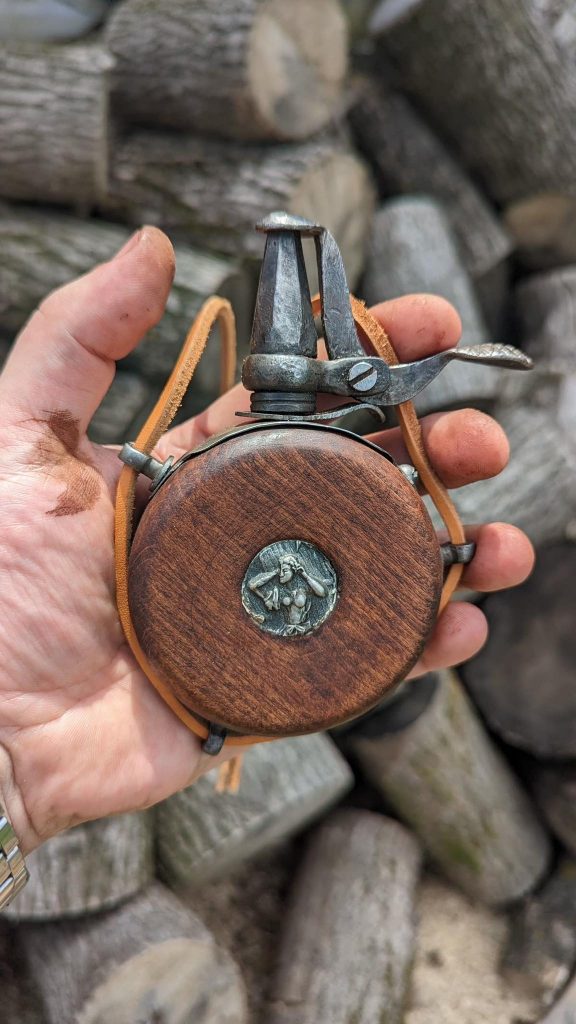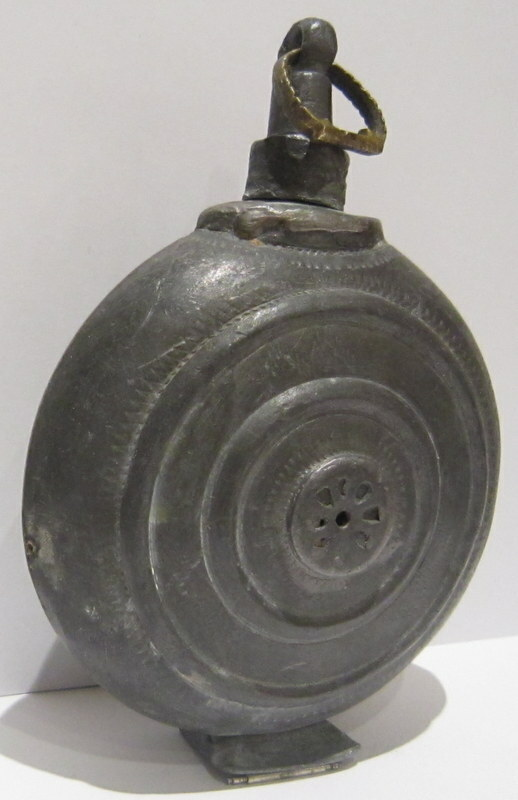The Little Object People Once Couldn’t Leave Home Without
You might pass it in an antique shop and think, “Pretty—what is it?” — but this small, round walnut-and-metal piece was once a soldier’s everyday companion. Known to collectors and historians as a powder flask or gunpowder primer, it played a simple but crucial role in the age of flintlock and percussion firearms. Ready to dig into its story? Let’s go.
What Is a Powder Flask (and Why It Looks Like That)
At first glance it’s elegant: a circular wooden body, metal fittings, a tiny hinged spout and often a strap for carrying. Utility met ornament here—craftspeople in the 18th and 19th centuries made flasks both functional and decorative.

- The body is commonly wood, horn, or metal (brass, copper, tin).
- The nozzle and cap are metal, often spring-loaded to control the flow.
- A leather strap allowed hunters and soldiers to carry it ready at their side.
- Many were inlaid or embossed with figures, coats of arms, or pastoral scenes—beautiful details that make them collectible today.
How It Worked: Simple, Precise, Ingenious
Think of the flask as a small, measured dispenser for black powder. You’d flip the cap with your thumb, tilt the flask so a calibrated amount fell into the pan or barrel, then close it. That tiny spring valve helped prevent spills and moisture exposure—two things you absolutely did not want near gunpowder.
Is it obvious yet why people treated these flasks like essential gear rather than mere trinkets?
Dating and Geography: When and Where These Were Used
Powder flasks were most common in Europe and North America from the late 1700s through the mid-1800s. They show up alongside flintlock muskets and early percussion firearms—before cartridges and integrated primers made them obsolete.
Video : Vintage Gunpowder Flask empty
Regional styles tell stories:
- British flasks often had regimental insignia or hunting motifs.
- Continental pieces might favor mythological or allegorical scenes.
- American examples can mix practicality with frontier aesthetics.
Why Collectors Love Them (and What Drives Value)
If you’re curious why a small flask sells for a lot at auctions, here’s the short list:
- Condition: intact wood and functioning nozzle = big plus.
- Rarity: unusual shapes, maker’s marks, or unique inlays increase value.
- Provenance: documented history or military association raises interest.
- Decoration: fine engravings, silver mounts, or figural insets make pieces stand out.
Beyond money, collectors are drawn to the human angle: these were everyday objects for hunters, soldiers, and travelers. They whisper stories.
Spotting Originals vs. Reproductions
If you find one at a flea market, how can you tell if it’s an authentic 19th-century flask or a modern reproduction?

- Patina and wear: real age shows as subtle wear, not just artificial distress.
- Joinery and manufacture: hand-filed metal and aged rivets point to authenticity.
- Materials: certain woods and alloys were common historically; modern plastics scream reproduction.
- Markings: maker’s stamps, military marks, or serials—these help validate age.
If you’re unsure, consult a reputable appraiser or local museum—don’t rely on a single internet photo for a big purchase.
Preservation Tips: How to Care for an Antique Flask
Handle with respect. These pieces are fragile and sometimes contain old residue.
- Don’t attempt to burn or clean old powder yourself. If you suspect residual black powder, contact specialists—old residues can be dangerous.
- Cleaning: dust with a soft brush. Avoid harsh solvents, and don’t submerge wood.
- Metal parts: gently polish only if you know how; sometimes the original patina is worth more than a bright shine.
- Storage: keep in stable temperature and humidity, out of direct sunlight.
- Display: cradle the flask on padded mounts and avoid hanging weight on old leather straps.
Stories These Objects Tell: From Campfires to Craftsmanship
Every dent and scratch has a backstory. A powder flask could have been part of a hunter’s kit, a militiaman’s uniform, or a family heirloom brought to a new continent. The carved female figure inset on the one in your photo? That’s not just ornamentation—it reflects period tastes, workshop skills, and the transatlantic style influences of the 19th century.
Video : Antique , vintage black powder flask for musket flintlock rifles , guns .
Ethics, Safety, and Historical Respect
It’s tempting to imagine flasks in action, but we should be careful. These are artifacts tied to technologies of war and hunting. Appreciating them means acknowledging past lives and contexts—both heroic and tragic. If you find one in the ground, report it to local authorities or a museum; many regions have laws protecting antiquities and burial contexts.
Where to Learn More (Without Getting Overwhelmed)
Want to dive deeper? Good places to start:
- Local historical societies and small museums often have exhibits.
- Reenactor groups and living-history sites can explain practical use without promoting harm.
- Specialist antique references and auction catalogs are great for identifying makers and styles.
Conclusion: Small Object, Big History
That little round flask you’re holding? It’s a compact time capsule. More than decoration, it’s a snapshot of everyday life in an era when people measured out powder by hand, trusted a spring valve with their safety, and expected their tools to be beautiful as well as useful. Whether you’re a collector, historian, or simply curious, a powder flask connects us to hands that prepared, aimed, and lived—reminding us that ordinary objects often carry extraordinary stories.